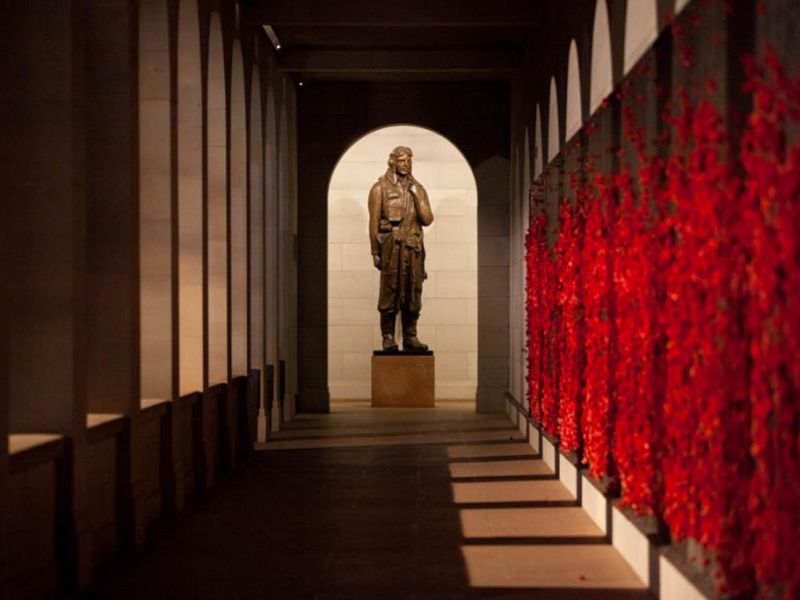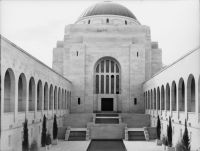Bombardier Ronald Rex Standen, 2/15th Field Regiment
Ronald Standen was born on 31 October 1919 in Armidale, New South Wales, the son of Arthur and Ellen Standen.
Known commonly by his middle name, “Rex”, he grew up alongside siblings Margaret, Trevor and David, and went on to find employment as a public servant.
Rex Standen enlisted at Martin Place in Sydney on 2 July 1940. Posted to the 6th Battalion, he was transferred to the 1st Regiment, Royal Australian Artillery.
After suffering a bout of influenza while training at Liverpool, to the west of Sydney – in late November Standen was transferred to the newly raised 2/15th Field Regiment.
The regiment began training at Ingleburn with 18-pounder guns – the type used during the First World War – many of which were older than the gunners. In January 1941 the regiment moved into the new Holsworthy camp in Sydney. In May, Standen and his unit moved to Bathurst, where they carried out joint training exercises.
In July, Standen was promoted to bombadier, and at the end of the month he and his regiment embarked at Sydney, bound for overseas service.
While the rest of the 2nd Australian Imperial Force had been sent to the Middle East, the 8th Division was sent Malaya, Singapore, and the islands to Australia’s north. Standen and the 2/15th went into camp at Singapore, where the men trained.
Throughout November and the start of December 1941 it seemed that war with Japan was increasingly likely. Late in the afternoon of the 5th of December, Standen’s unit began moving from Singapore across the straits to the state of Johore, in Malaya, to relieve the 2/10th Field Regiment. The 2/10th was operating on the east coast of Malaya in support of the 8th Division's 22nd Brigade. The 2/15th was headquartered and took up position at Kluang Rubber Estate.
By the start of January 1942 the Japanese had advanced through Thailand and most of Malaya. The 2/15th left Kluang and moved north to reinforce the Allied troops who would fight the main Japanese force when it reached Johore. The regiment’s batteries went to Muar on the west coast; also further north to join the 27th Brigade, to Paya Lang Estate under the command of the 2/29th Battalion; and near Gamas under the command of the 2/30th Battalion.
Soon after moving into position, the regiment's gunners were in almost constant action, providing artillery support for the infantry withdrawal along the Malyan Peninsula towards Singapore. In the first days of the campaign, the regiment fired 7,950 rounds in the Gemas–Segamat sector alone. By the end of the month, the last of the Allied troops had crossed the causeway and reached Singapore. Among the last to cross were troops from the 2/15th who formed the last Allied artillery units in action on the peninsula.
Having crossed the causeway, which was subsequently blown up, the regiment was deployed to the western area in support of the 22nd Brigade.
Preceded by a heavy bombardment, the Japanese attack on Singapore began at 10.30 pm on 8 February, when two Japanese divisions crossed the Johore Strait. The 2/15th inflicted heavy casualties on the attackers and sank some barges. But with communications cut, heavily outnumbered, and the Japanese infiltrating between positions, the regiment withdrew towards Singapore, providing artillery support when needed.
By 13 February the battle for Singapore Island was all but over, and two days later British forces surrendered. The regiment began moving from Tanglin Golf Course to Selerang Barracks, Changi, and into Japanese capture.
Initially imprisoned in the sprawling Changi prisoner-of-war camp, members of the 2/20th were soon allocated to external work parties. The first parties were dispatched around Singapore and southern Malaya. But later, members of the 2/15th found themselves in work parties bound for the camps along the Thailand–Burma Railway and in Borneo – as well as in Japan, French Indochina, Java, Sumatra, and Malaya.
While the horrors of Japanese captivity are well known, particularly the experiences of those forced to work on the Burma–Thailand Railway, the worst and most dangerous period in a prisoner’s life was travelling in captivity. Over-crowding, sickness, disease and the dangers posed by Allied submarines caused stress and anxiety. Conditions on board ships were severe: over 1,000 prisoners might be crammed into spaces suitable for a few hundred, and given little food, fresh water, or adequate sanitation facilities. The prisoners of war called these transports “hellships”.
In September 1944, the Rakuyō Maru and Kachidoki Maru were transporting Australian and British prisoners of war from Singapore to Japan. The prisoners were all survivors of the Burma-Thailand Railway.
On the morning of 12 September 1944 the convoy was attacked by American submarines in the South China Sea. Rakuyō Maru was sunk by USS Sealion II and Kachidoki Maru by USS Pampanito. Prisoners able to evacuate the ships spent the following days in life-rafts or clinging to wreckage in open water. About 150 Australian and British survivors were rescued by American submarines. A further 500 were picked up by Japanese destroyers and continued the journey to Japan. Those who were not rescued, perished at sea. A total of 1,559 Australian and British prisoners of war were killed in the incident, all missing at sea. The total number of Australians killed was 543.
Among the dead was Ronald Standen. He was 24 years old.
With no grave but the sea, today he is commemorated at the Labuan Memorial in Malaysia, which commemorates over 2,000 men who died while prisoners of war in Borneo and the Philippines and have no known grave.
- AWM Honour Roll https://www.awm.gov.au/collection/R1698454

 Australian War Memorial
Australian War Memorial